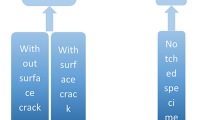Abstract
This study focuses on the evaluation of the effect of hygrothermal conditioning on tensile, compressive, in-plane and interlaminar shear properties, and also on the viscoelastic characteristics of carbon fiber/epoxy laminates. Flat unidirectional laminates were manufactured by dry filament winding and cured under hot compression. The laminates were later exposed to hygrothermal conditioning in a chamber, following the recommendations of ASTM D5229M. All composite coupons were tested before and after conditioning. An analytical Fickian model was used to fit experimental data, showing very good estimates. Shear strength and modulus reduced to about 30 and 38 %, respectively. All specimens presented acceptable failure modes; shear specimens failed at the gage section with delaminations and fiber/matrix debonding, whereas short beam specimens failed via delaminations at the specimen mid-plane. Moisture penetration through the carbon/epoxy surface lead to interfacial debonding and matrix plasticization. Puck’s failure envelope accurately predicted failure under compressive and shear loading.


















Similar content being viewed by others
References
Botelho EC, Costa ML, Pardini LC, Rezende MC (2005) Processing and hygrothermal effects on viscoelastic behavior of glass fiber/epoxy composites. J Mater Sci 40(14):3615–3623. doi:10.1007/s10853-005-0760-2
Almeida JHS Jr, Faria H, Marques AT, Amico SC (2014) Load sharing ability of the liner in type III composite pressure vessels under internal pressure. J Reinf Plast Compos 33(24):2274–2286
Pillay S, Vaidya UK, Janowski GM (2009) Effects of moisture and UV exposure on liquid molded carbon fabric reinforced nylon 6 composite laminates. Compos Sci Technol 69(6):839–846
Bao L-R, Yee AF (2002) Moisture diffusion and hygrothermal aging in bismaleimide matrix carbon fiber composites: part II-Woven and hybrid composites. Compos Sci Technol 62(16):2111–2119
Zhang A, Lu H, Zhang D (2014) Synergistic effect of cyclic mechanical loading and moisture absorption on the bending fatigue performance of carbon/epoxy composites. J Mater Sci 49(1):314–320. doi:10.1007/s10853-013-7707-9
Zheng Q, Morgan RJ (1993) Synergistic thermal-moisture damage mechanisms of epoxies and their carbon fiber composites. J Compos Mater 27(15):1465–1478
Bao L-R, Yee AF (2002) Effect of temperature on moisture absorption in a bismaleimide resin and its carbon fiber composites. Polymer 43(14):3987–3997
Kumar BG, Singh RP, Nakamura T (2002) Degradation of carbon fiber-reinforced epoxy composites by ultraviolet radiation and condensation. J Comp Mater 36(24):2713–2733
Mouzakis DE, Zoga H, Galiotis C (2008) Accelerated environmental aging study of polyester/glass fiber reinforced composites (GFRPCs). Compos B 39(3):467–475
Batista NL, Faria MCM, Iha K, Oliveira PC, Botelho EC (2015) Influence of water immersion and ultraviolet weathering on mechanical and viscoelastic properties of polyphenylene sulfide–carbon fiber composites. J Thermoplast Compos Mater 28(3):340–356
Botelho EC, Pardini LC, Rezende MC (2006) Hygrothermal effects on the shear properties of carbon fiber/epoxy composites. J Mater Sci 41(21):7111–7118. doi:10.1007/s10853-006-0933-7
Tsai YI, Bosze EJ, Barjasteh E, Nutt SR (2009) Influence of hygrothermal environment on thermal and mechanical properties of carbon fiber/fiberglass hybrid composites. Compos Sci Technol 69(3–4):432–437
Sun P, Zhao Y, Luo Y, Sun L (2011) Effect of temperature and cyclic hygrothermal aging on the interlaminar shear strength of carbon fiber/bismaleimide (BMI) composite. Mater Des 32(8–9):4341–4347
Tsai SW, Wu EM (1971) A general theory of strength for anisotropic materials. J Compos Mater 5(1):58–80
Tsai SW (1965) Strength characteristics of composite materials, NASA technical report CR-224
Hashin Z (1979) Analysis of properties of fiber composites with anisotropic constituents. J Appl Mech 46(3):543–550
Christensen RM (1997) Stress based yield/failure criteria for fiber composites. Int J Solid Struct 34(5):529–543
Puck A, Mannigal M (2007) Physically based non-linear stress-strain relations for the inter-fiber fracture analysis of FRP laminates. Compos Sci Technol 67(9):1955–1964
Karbhari VM, Xian G (2009) Hygrothermal effects on high VF pultruded unidirectional carbon/epoxy composites: moisture uptake. Compos B 40(1):41–49
Jiang X, Kolstein H, Bijlaard F, Qiang X (2014) Effects of hygrothermal aging on glass-fibre reinforced polymer laminates and adhesive of FRP composite bridge: moisture diffusion characteristics. Compos A 57:49–58
Chandra R, Singh SP, Gupta K (1999) Damping studies in fibre-reinforced composites—a review. Compos Struct 46(1):41–51
Nakanishi Y, Hana K, Hamada H (1997) Fractography of fracture in CFRP under compressive load. Compos SciTechnol 57(8):1139–1147
Pinho ST, Iannucci L, Robinson P (2006) Physically-based failure models and criteria for laminated fibre-reinforced composites with emphasis on fibre kinking: part I: Development. Compos A 37(1):63–73
Almeida JHS Jr, Angrizani CC, Botelho EC, Amico SC (2015) Effect of fiber orientation on the shear behavior of glass fiber/epoxy composites. Mater Des 65:789–795
Whitney JM, Browning CE (1985) On short-beam shear tests for composite materials. Exp Mech 25(3):294–300
Silva LV, Júnior JHSA, Angrizani CC, Amico SC (2013) Short beam strength of curaua, sisal, glass and hybrid composites. J Reinf Plast Compos 32(3):197–206
Sun CT, Tao J (1998) Prediction of failure envelopes and stress/strain behaviour of composite laminates. Compos Sci Technol 58(7):1125–1136
Acknowledgements
The authors would like to thank CAPES, FAPESP, CNPq, and AEB (Brazilian Space Agency) for the financial support.
Author information
Authors and Affiliations
Corresponding author
Rights and permissions
About this article
Cite this article
Almeida, J.H.S., Souza, S.D.B., Botelho, E.C. et al. Carbon fiber-reinforced epoxy filament-wound composite laminates exposed to hygrothermal conditioning. J Mater Sci 51, 4697–4708 (2016). https://doi.org/10.1007/s10853-016-9787-9
Received:
Accepted:
Published:
Issue Date:
DOI: https://doi.org/10.1007/s10853-016-9787-9




